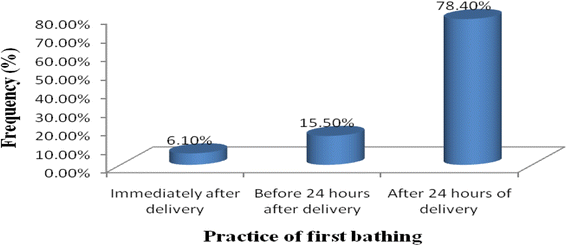Knowledge, practice and associated factors of essential newborn care at home among mothers in Gulomekada District, Eastern Tigray, Ethiopia, 2014
- PMID: 27329372
- PMCID: PMC4915039
- DOI: 10.1186/s12884-016-0931-y
Knowledge, practice and associated factors of essential newborn care at home among mothers in Gulomekada District, Eastern Tigray, Ethiopia, 2014
Abstract
Background: Around the world, more than three million newborns die in their first months of life every year. In Ethiopia during the last five years period; neonatal mortality is 37 deaths per 1000 live births. Even though there is an improvement compared to the past five years, there is still high home delivery 90 %, and high neonatal mortality about the Millennium Development Goal, which aims to be less than 32/1000 live births in Ethiopia. The purpose of this study is to assess maternal knowledge, practice and associated factors of essential newborn care at home in Gulomekada District Eastern Tigray, Ethiopia.
Methods: A community-based cross-sectional study is conducted in 296 mothers from Gulomekada District by using simple random sampling technique. Data entry and analysis is carried out by using Statistical Package for Social Sciences-20. The magnitude of the association between different variables about the outcome variable is measured by odds ratio with 95 % confidence interval. A binary logistic regression analysis is made to obtain odds ratio and the confidence interval of statistical associations. The goodness of fit had tested by Hosmer-Lemeshow statistic and all variables with P-value greater than 0.05 are fitted to the multivariate model. Variables with P < 0.2 in the bivariate analysis are included in the final model, and statistical significance is declared at P < 0.05.
Result: Eighty percent (80.4 %) study participants had good knowledge on essential new born care and 92.9 % had the good practice of essential new born care. About 60 % of mothers applied butter or oil on the cord stump for their last baby. Marital status and education are significantly associated with knowledge, whereas urban residence mothers with good knowledge on essential newborn care and employed mothers are significantly associated with mothers' practice of essential newborn care.
Conclusion: Almost all mothers know and practice essential newborn care correctly except oil or butter application to the cord stump is highly practiced which should be avoided. Only marital status and educational status are significantly associated with mothers' knowledge.
Keywords: Essential newborn care; Knowledge; Practice.
Figures



Similar articles
-
Essential neonatal care utilization and associated factors among mothers in public health facilities of Aksum Town, North Ethiopia, 2016.PLoS One. 2017 Apr 19;12(4):e0175902. doi: 10.1371/journal.pone.0175902. eCollection 2017. PLoS One. 2017. PMID: 28423043 Free PMC article.
-
Essential newborn care practices and associated factors among home delivered mothers in Damot pulasa Woreda, southern Ethiopia.Reprod Health. 2018 Sep 27;15(1):162. doi: 10.1186/s12978-018-0609-1. Reprod Health. 2018. PMID: 30261886 Free PMC article.
-
Colostrum avoidance practice and associated factors among mothers of children aged less than six months in Bure District, Amhara Region, North West, Ethiopia: A community-based cross-sectional study.PLoS One. 2021 Jan 29;16(1):e0245233. doi: 10.1371/journal.pone.0245233. eCollection 2021. PLoS One. 2021. PMID: 33513154 Free PMC article.
-
Essential newborn care utilization and associated factors in Ethiopia: a systematic review and meta-analysis.BMC Pregnancy Childbirth. 2020 Feb 24;20(1):124. doi: 10.1186/s12884-020-2804-7. BMC Pregnancy Childbirth. 2020. PMID: 32093648 Free PMC article.
-
An update on factors affecting umbilical cord care among mothers: A review.Medicine (Baltimore). 2024 Jul 12;103(28):e38945. doi: 10.1097/MD.0000000000038945. Medicine (Baltimore). 2024. PMID: 38996124 Free PMC article. Review.
Cited by
-
Community Based Essential Newborn Care Practices and Associated Factors among Women Who Gave Birth at Home in Last 12 Months in Amaro Woreda, Southern Ethiopia, 2019.Glob Pediatr Health. 2021 May 24;8:2333794X211016151. doi: 10.1177/2333794X211016151. eCollection 2021. Glob Pediatr Health. 2021. PMID: 34104692 Free PMC article.
-
Knowledge, attitude, and practice among mothers about newborn care in Sindh, Pakistan.BMC Pregnancy Childbirth. 2019 Sep 6;19(1):329. doi: 10.1186/s12884-019-2479-0. BMC Pregnancy Childbirth. 2019. PMID: 31492146 Free PMC article.
-
Essential newborn care practice and its associated factors in Southwest Ethiopia.Arch Public Health. 2021 Mar 31;79(1):42. doi: 10.1186/s13690-021-00568-6. Arch Public Health. 2021. PMID: 33789738 Free PMC article.
-
Multilevel analysis of individual and community level factors associated with the application of cow dung and oil on the umbilical cord stump in Ethiopia.Front Pediatr. 2022 Nov 7;10:1044056. doi: 10.3389/fped.2022.1044056. eCollection 2022. Front Pediatr. 2022. PMID: 36419914 Free PMC article.
-
Early newborn bathing and associated factors among mothers in Afar Region, Northeast Ethiopia.J Trop Pediatr. 2022 Dec 5;69(1):fmac117. doi: 10.1093/tropej/fmac117. J Trop Pediatr. 2022. PMID: 36625889 Free PMC article.
References
-
- WHO . Neonatal and Perinatal Mortality Country, Regional and Global Estimates. 2006.
-
- Central Statistical Agency. Ethiopian Demographic and Health Survey. Central Statistical Agency: Addis Ababa; 2011.
-
- UNICEF . Levels and trends in child mortality report. 2012.
-
- The Partnership. Opportunities for Africa’s New born. accessed on 30 December 2013 retrieved at http://www.who.int/pmnch/media/publications/oanfullreport.pdf.
Publication types
MeSH terms
LinkOut - more resources
Full Text Sources
Other Literature Sources
Medical
Miscellaneous

